Back to Journals » Psychology Research and Behavior Management » Volume 15
Determinants of Work-Related Stress Among Nurses Working in Private and Public Hospitals in Dessie City, 2021: Comparative Cross-Sectional Study
Authors Tsegaw S, Getachew Y, Tegegne B
Received 26 May 2022
Accepted for publication 20 July 2022
Published 26 July 2022 Volume 2022:15 Pages 1823—1835
DOI https://doi.org/10.2147/PRBM.S372882
Checked for plagiarism Yes
Review by Single anonymous peer review
Peer reviewer comments 2
Editor who approved publication: Dr Igor Elman
Shbre Tsegaw,1 Yemiamrew Getachew,2 Belachew Tegegne3
1Department of Nursing, Dessie Health Science College, Dessie, Ethiopia; 2Department of Community and Mental Health, School of Nursing and Midwifery, College of Medicine and Health Sciences, Wollo University, Dessie, Ethiopia; 3Department of Comprehensive Nursing, School of Nursing and Midwifery, College of Medicine and Health Sciences, Wollo University, Dessie, Ethiopia
Correspondence: Belachew Tegegne, Email [email protected]
Background: Globally, work-related stress had a significant impact on health-care providers. Private and public health-care institutions are considered intensive work areas for work-related stress. In Ethiopia, most studies were focused on only public hospitals. However, this study aimed to include private and public hospitals.
Methods: A hospital-based comparative cross-sectional study was conducted among 304 nurses working in public and private hospitals from 8 April to 7 May 2021. A simple random sampling technique was used to select nurses, and the data were collected using a standardized self-administered questionnaire. Data were entered into Epidata version 4.6.1 and then exported to SPSS version 26 for analysis. Descriptive statistics, bivariable and multivariable binary logistic regression were applied. The final multivariate regression declared significant determinants at a p-value < 0.05 and a 95% confidence interval with an adjusted odds ratio (AOR) to reveal the strength of associated variables.
Results: In this study, the overall magnitude of work-related stress among nurses was 48.4% (95% CI: 42.4– 54.6) (51.6% among public hospitals and 46.4% for private hospitals). Bachelor nurses (AOR=0.32,95% CI:0.13,0.76), working in operation room (AOR=7.89, 95% CI:1.46,9.60) and job dissatisfaction (AOR=4.95, 95% CI: 1.94,2.61) were determinants of work-stress in private hospitals whereas being female (AOR = 3.15, 95% CI: 1.43, 6.92), working experience 5 to 10 years (AOR=0.42, 95% CI: 0.18, 0.97), having degree and above (AOR = 0.41, 95% CI: 0.17, 0.99) and working in intensive care unit (AOR = 6.48, 95% CI:1.49, 8.18) were determinants of work-related stress in public hospitals.
Conclusion: The overall magnitude of work-related stress among nurses in Dessie city was almost half. In contrast, more work-related stress among nurses working in public hospitals than in private hospitals. Sex, operating (working) unit, working experience, and type of institution were work-related stress determinants in public and private hospitals. Hence, reducing workload and providing stress management training is crucial to reducing work-related stress among nurses.
Keywords: determinants, nurses, work related stress
Background
Work-related stress is the response of people that exists when work stressors are unmatched with their knowledge, skills, or abilities which challenges their coping mechanisms.1 Nurses faced with severe illness and the death of patients that makes nursing as highly stressful profession.2 It promotes organizational incompetency, high staff turnover, sickness, absenteeism, decrease quality of care, increased costs of health care, and reduced job satisfaction.3
Work-related stress among nurses is a global problem. The study done in the USA revealed that 93% of the nurses had high levels of stress.4 A study conducted in China indicated that 68.3% of the nurse had high occupational stress.5 A study in Iran showed that most of the nurses (63.47%) experienced stress.6 In Saudi-Arabia, 34.7% of nurses suffer from work-related stress.7 A study conducted in Slovenia showed that prevalence of occupational stress was 56.5%.8 A study that was carried out in Botswana revealed that a higher percentage (74%) of nurses have ever experienced occupational stress.9 The condition of work load among nurses in Ethiopia was high because of shortage of nurses. Studies in different parts of Ethiopia revealed that the magnitude of work-related stress among nurses was ranged from 37.8% to 66.2%.10–12
Work-related stress had negative impacts on individuals and organizations. Job dissatisfaction, lower motivation, insomnia, psychological distress, depression, anxiousness, aggressiveness, loss of self-confidence, loss of concentration, cardiovascular diseases, high cholesterol, and high blood glucose level are consequences at individuals whereas increasing organizational cost and failure to meet organizational goals were reported at the organization level.13 Furthermore, stress enhances the cost for health care and reduces job satisfaction. Additionally, absenteeism and turnover among the staffs reduces the quality of health care and client satisfaction.14
The impact of work-related stress at economy and social life includes; during illness time or occupational hazard, the organization covers the cost of treatment and provides money for compensation which reduces productivity of the organization.15 The United States costs over $300 billion yearly for different accidents, insurance costs, absenteeism and turnover of staff. The cost of work-related stress in fifteen European countries was around 20 billion Euros.15
According to WHO, strategies to solve work stress problems among nurses include changing the demands of work by sharing the work load differently, developing the employees’ knowledge and skills by giving training,16 creating a fun work environment, encouraging new learning experiences among staffs, motivating staff through tangible and intangible rewards.12
Socio-demographic characteristics, behavioral factors, work-environment factors (work shift, working unit, work experience, working hours per week, assigned position, and job satisfaction) were determinants of work-related stress among nurses.7,11,12 The prevalence of work-related stress in Africa is high. Researchers on work-related stress reported that in the most organizations about one-third of employees reported high levels of stress while one-quarter of workers ranked their job as the highest stressful one.17
In Ethiopia, the studies showed that work-related stress was the major problem. As far as the investigators dig out previous studies in Ethiopia were done by a single cross-sectional study design and focused only public hospitals. However, this study was used a comparative cross-sectional study and includes both private and public hospitals to increase the generalizability of the findings. Additionally, there was no study conducted to address the magnitude of work-related stress in the study area. Thus, this study aimed to address the gap by comparing work-related stress and identifying its determinants among nurses working in public and private hospitals in Dessie city.
Methods and Materials
Study Design and Study Area Description
Hospital-based comparative cross-sectional study was conducted in Dessie city from 8 April to 7 May 2021. Dessie is the city of South Wollo zone and located 401 kilometers away from Addis Ababa. The city is found at an altitude of 2470 to 2550 meters above sea level. There are two public hospitals (Dessie comprehensive specialized hospital and Boru Meda hospital), six private hospitals (Selam hospital, Ethio hospital, Bati hospital, Meseret hospital, Tossa hospital, Kalu hospital). There are 460 nurses who are working in both public and private hospitals (159 nurses in private and 301 in public hospitals).
Source and Study Population
All nurses who had worked at public and private hospitals were the source population whereas all nurses who had worked at public and private hospitals during the study period were the study population.
Eligibility Criteria
All nurses who had worked in public and private hospitals during the study period were included from the study while nurses on maternity and annual leave, and nurses with a serious illness during the data collection period were excluded from the study.
Sample Size Determination and Sampling Technique
The sample size was determined using the double population proportion formula by considering the following statistical assumptions: 95% CI, the proportion of work-related stress among nurses in public hospitals (P1 = 66.2%) from the study done in Harar,12 and the proportion of work-related stress among nurses working in private hospitals (P2 = 50%) because no published study about work-related stress among nurses working in private hospitals. Alpha ( ) type one error,
) type one error,  is type two error, power = 80%, confidence level = 1.96
is type two error, power = 80%, confidence level = 1.96  .18
.18
After adding a 10% non-responses rate, the final sample size was 312 (156 for private and 156 for public hospitals). Proportional allocation was performed for each hospital to select the number of nurses working in public and private hospitals. The ratio of public and private hospitals was one to one (1:1). The list of all nurses was obtained from payroll in the human resource management office in the study hospitals and computer-generated simple random sampling technique was used to select 312 study participants.
Outcome variable: Work-related stress.
Independent Variables
Socio demographic factors (age, sex, marital status, level of education, monthly salary, number of children).
Work-environment factors (types of institution, work shift, working unit, work experience, working hours per week, job satisfaction and assigned position).
Behavioral factor: substance abuse.
Social-related factors (conflict with physician, problems with peers, and problems with supervisors, patient and family).
Psychological factors (death and dying, uncertainty concerning treatment, inadequate emotional preparation).
Physical factor (work load).
Operational Definitions
Work-Related Stress
Nurse stress was measured by using Expanded Nursing Stress Scale (ENSS) which contains 57 items rated from 1 (never stressful) to 4 (always stressful) and it has nine subscales categorized into three factors (social factors, physical factors, and psychological factors).12
Stressed
Those nurses who scored mean and above the mean value of ENSS questions.11,12
Non-stressed
Those nurses who scored less than the mean value of ENSS questions.11,12
Physical Factors
Refers to the source of stress which is measured by a variable: workload in ENSS.19
Social Factors
Refers to the sources of stress which are measured by variables: eg, conflict with a physician, problems with peers, and problems with supervisors in ENSS.19
Psychological Factors
Refers to sources of stress which can be measured by variables such as death and dying, inadequate emotional preparation, and uncertainty concerning the treatment in ENSS.19
Job Satisfaction
Participants who scored mean and above the mean were considered as satisfied on McCloskey/Mueller satisfaction scale.20,21
Job Dissatisfaction
Participants who score below the mean were considered as dissatisfied in McCloskey/Mueller satisfaction scale.20,21 Job Satisfaction rated from 1(very dissatisfied) to 4(very satisfied).
Substance Use
Consumption of any substance (alcohol, chat, cigarettes, sedatives or sleeping pills, and opioids in their lifetime.12
Substance Abuse
Excessive use of alcohol, chat, cigarettes, sedatives or sleeping pills, and opioids whose risk level is moderate and high with a score of >5 in WHO ASSIST substance abuse measuring tool.22
Data Collection Tools and Procedure
Four diploma nurses were assigned for data collection and two bachelor nurses for supervision. The data were collected by using pre-tested self-administered questionnaires. The questionnaire had five parts. Part I socio-demographics; part II work environment characteristics; Part III ENSS (modified expanded nursing stress scale). The ENSS is an expanded and updated version of the classic Nursing Stress Scale which was adopted from a previous study (The Cronbach’s alpha was found to be 0.86 for the overall scales).12 The ENSS contains 57 items which assess 9 dimensions. This includes death and dying (7 items), conflict with physicians (5 items), inadequate emotional preparation (3 items), problems relating to peers (6 items), problems relating to supervisors (7 items), workload (9 items), patients and their families (8 items), discrimination (3 items); and, treatment uncertainty (9 items). Participants were asked to indicate the frequency of work-related stress using a 4-point Likert scale (1 = never stressful to 4 = always stressful). Part IV Job satisfaction scale which is measured by the McCloskey/Mueller Satisfaction Scale (MMSS) which was adapted from a previous study with Cronbach’s alpha 0.90).21 This scale is a four-point Likert type scale (1 = very dissatisfied, 4 = very satisfied) with eight subscales and 29 items. Lastly, Part V includes behavioral factors that include the WHO ASSIST substance abuse measuring tool.
Data Quality Assurance
First, the questionnaire was prepared in English then translated to Amharic and again back to English to keep its consistency. Prior to data collection, 5% of the tool was pre-tested at Hidar 11 general Hospital and training was given to data collectors (enumerators) and supervisors. During the study period, the collected data were checked continuously on a daily basis for completeness by the principal investigator and supervisors.
Data Processing and Analysis
The collected data were checked for completeness, coded, and entered into Epidata version 4.6.1 and then exported to SPSS version 26 for analysis. Descriptive statistics were used to explain mean, median and frequency of study variables. Bivariable and multivariable binary logistic regression analyses were performed to identify the presence of an association between outcome and explanatory variables. In bivariable logistic regression variables having a p-value <0.25 were a candidate for multivariable logistic regression. From the multivariable logistic regression analysis, variables having a p-value less than 0.05 and adjusted odds ratio (AOR) with a 95% confidence interval (CI) were used to declare significant variables. The model fitness was checked by using the Hosmer-Lemeshow goodness-of-fit test.
Results
Socio-Demographic Characteristics of Participants
Totally, 304 nurses were involved in the study with a response rate of 97.4% (304/312). From public hospitals, 153 nurses with a response rate of 98.1% (153/156), and private hospitals 151 nurses with a response rate of 96.8% (151/156) were participated in the study. More than half, 81 (53.6%) in private hospitals and 95 (62.1%) in public hospitals were males. The mean (±SD) age of nurses was 31.3 ± 6.7 years (31.5 ± 6.1 for private and 31.2 ± 7.2 for the public hospitals). Nearly half, 74 (49.0%) of nurses in private hospitals and 99 (64.7%) in public hospitals were married (Table 1).
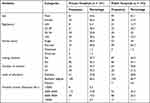 |
Table 1 Socio-Demographic Characteristics of Nurses Working in Private and Public Hospitals, Dessie City, Northeast Ethiopia, April 8 to May 7, 2021 (n = 304) |
Work- Environment Related Factors
Most of the participants, 126 (83.5%) in private, and 137 (89.5%) in public hospitals had worked in inpatient departments. The majority of nurses, 102 (67.5%) in private hospitals had worked rotating shifts while 144 (94.1%) of nurses in public hospitals had worked fixed shifts (Table 2).
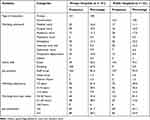 |
Table 2 Work Environment-Related Factors of Nurses Working in Private and Public Hospitals, Dessie City, Northeast Ethiopia, April 8 to May 7, 2021 (n = 304) |
Behavioural Factors
Lifetime substance utilization revealed that 19 (12.6%) from private, and 37 (24.2%) from public hospitals had substance utilization history from the listed substances. Among participants who had substance utilization history, 18 (94.7%) from private and 29 (78.4%) from public hospitals had a history of alcohol drinking (Table 3).
 |
Table 3 Substance Use Characteristics of Nurses Working in Private and Public Hospitals, Dessie City, Northeast Ethiopia, April 8 to May 7, 2021 (n = 304) |
The Overall Magnitude of Work-Related Stress Among Nurses
The response of all nurses was computed, and the mean was obtained after checking the normal distribution by histogram. The overall mean (±SD) score of work-related stress was 2.28(±0.49) [private hospitals, 2.13(±0.42), and public hospitals, 2.44(±0.51)]. This mean value was used to categorize nurses into two groups. Nurses who had scored ≥2.28 (±0.49) were considered as stressed, and those nurses who had scored <2.28(±0.49) were considered as not stressed. Accordingly, 147 (48.4%, 95% CI: 42.4, 54.6) nurses were stressed (Figure 1). The magnitude of work-related stress in private and public hospitals was 46.4% (95% CI: 42.1, 50.3) and 51.6% (95% CI: 51.2, 59.5), respectively (Figure 2).
 |
Figure 1 The overall magnitude of work-related stress among nurses working in private and public hospitals, Dessie city, Northeast Ethiopia, April 8 to May 7, 2021 (n = 304). |
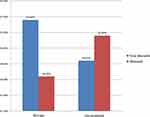 |
Figure 2 The magnitude of work-related stress among nurses in private and public hospitals, Dessie city, Northeast Ethiopia, April 8 to May 7, 2021 (n = 304). |
Work Related Stressors Among Nurses Based on Expanded Nurse Stress Scale (ENSS)
Stressors from each sub-scale descending mean stress level were death and dying, workload, and uncertainty concerning treatment, with a mean score of 3.18, 2.82, and 2.19, respectively. Death & dying and workload were the most stressful subscales in both private and public hospitals (Table 4).
 |
Table 4 The Mean of Work-Related Stressors Among Nurses Working in Private and Public Hospitals, Dessie City, Northeast Ethiopia, April 8 to May 7, 2021 (n = 304) |
Determinants of Work Related Stress in Private Hospitals
First, bivariable analysis was performed, and eight variables with a p-value of less than 0.25 were candidates for multivariable binary logistic regression. In multivariable logistic regression, educational status, working unit, and job satisfaction were determinants of work-related stress in private hospitals. The level of education was associated with work-related stress. Nurses who had bachelor’s degrees and above were 68% less likely to have work-related stress as compared to diploma nurses (AOR = 0.32, 95% CI:0.13, 0.76). Working unit was associated with work-related stress. Accordingly, nurses who had worked in the operation room were eight folds more likely to have work-related stress as compared to nurses who had worked in OPD (AOR = 7.89, 95% CI: 1.46,9.60).. Dissatisfiednurses were about five times more likely to have work-related stress as compared to satisfied nurses (AOR = 4.95, 95% CI: 1.94, 2.61) (Table 5).
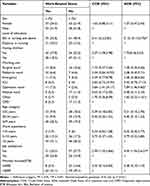 |
Table 5 Determinants of Work-Related Stress Among Nurses Working in Private Hospitals, Dessie City, Northeast Ethiopia, April 8 to May 7, 2021 (n = 151) |
Determinants of Work Related Stress in Public Hospitals
First, a bivariable analysis was carried out, and five variables were candidates for multivariable logistic regression. In multivariable analysis; sex, experience (service year), educational status, and unit of working were determinants of work-related stress. Female nurses were 3.15 fold more likely to have work-related stress as compared to male nurses (AOR = 3.15, 95% CI: 1.43, 6.92). Nurses who had five to ten years of work experience were 58% less likely to have work-related stress as compared to nurses who had less than five years of work experience (AOR = 0.42, 95% CI: 0.18, 0.97). Nurses who had worked in ICU were 6.48 times more likely to have work-related stress as compared to nurses who had worked in OPD (AOR = 6.48, 95% CI:1.49, 8.18). Bachelor and above nurses were 59% less likely to have work-related stress as compared to diploma nurses (AOR = 0.41, 95% CI: 0.17, 0.99) (Table 6).
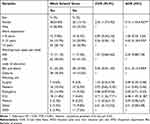 |
Table 6 Determinants of Work-Related Stress Among Nurses Working in Public Hospitals, Dessie City, Northeast Ethiopia, April 8 to May 7, 2021 (N = 153) |
Over All Determinants of Work Related Stress Among Nurses Worked Both in Private and Public Hospitals
In bivariable logistic analysis, nine9 variables were retained to multivariable regression, and four variables including sex, type of institution, working unit, and service year were determinants of work-related stress. Female nurses were about two fold more likely to have work-related stress as compared to male nurses (AOR = 1.87, 95% CI: 1.06, 3.31). Nurses who had worked in public hospitals were about 4 times more likely to have work-related stress as compared to their counter parts (AOR=4.06, 95% CI: 1.79, 9.21). Nurses who had worked in ICU and OR were five and four times more likely to have work-related stress as compared to nurses who had worked in OPD, respectively (AOR = 5.24, 95% CI: 1.69, 6.28), (AOR = 3.71, 95% CI: 1.07, 13.01). Nurses who had five to ten years of work experience were 60% less likely to have work-related stress as compared to nurses who have less than five years of work experience (AOR = 0.40, 95% CI: 0.19, 0.83) (Table 7).
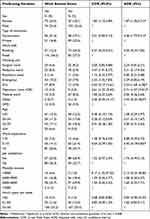 |
Table 7 Overall Determinants of Work-Related Stress Among Nurses Working in Private and Public Hospitals, Dessie City, Northeast Ethiopia, April 8 to May 7, 2021 (n = 304) |
Discussion
Many nurses develop physical and psychological disorders due to work-related stress. It increases nurse turnover, frequent leave, dissatisfaction, and absenteeism in private and public hospitals.23 Thus, the study aimed to compare work-related stress among nurses working in private and public hospitals in Dessie city, Northeast Ethiopia.
In this study, the overall magnitude of work-related stress was 48.4% (95% CI: 42.4–54.6). The finding is in line with studies done in Iran (49.5%),24 and Mekele (46.9%), Ethiopia.20 However, this finding is lower than previous studies in USA (93%),4 China (68.3%),5 Botswana (74%)9 and Jimma (56.3%)25 and Harar (66.2%),12 Ethiopia. The possible justification for this discrepancy might be the study participants were public nurses, which resulted in overestimated work-related stress as compared to this study, which includes both public and private hospital nurses in order to reduce over and underestimation of work-related stress.
On the other hand, this finding was higher than the study conducted in Arar city, Saudi Arabia (35%),7 Ghana (21.1%)26 and Addis Ababa (37.8%),27 Ethiopia. The justification for this difference might be due to assessment tools and study area. In Ghana, the tool was the nurses’ stress index whereas in Saudi, work stressor questionnaire was used and in Addis Ababa, the researcher was used the 34 items of the NSS (nurses stress scale).
Regarding determinants of work-related stress; Female nurses were more stressed than male nurses. This was consistent with the study in Goa, India, East Gojam, and Addis Ababa, Ethiopia.11,27,28 One of the explanations might be the similarity in biological factors and the higher role of the females in the family and society. However, this finding was contradicted with the study done in Iran that states female nurses had lower stress than male nurses.29 The reason might be due to sociodemiographic characteristics of study participants.
Type of institution was determinant of work-related stress. Accordingly, nurses who had worked in public hospitals were more stressed than nurses who had worked in private hospitals. This is congruent with a study performed in Uganda.30 The justification might be public hospitals nurses’ face with high workload because of high patient follow; this is due to most of the population having low socioeconomic status and wants to get the service in public hospitals. In addition, in public hospitals, clients get service by community-based insurance and low cost as compared to private hospitals. However, study done in Nigeria revealed that working environment and work-related stress has no any association.2 The variation might be due to difference in study area (setting).
Working unit was determinants of work-related stress. Nurses who had worked in ICU and OR had more stressed than nurses who had worked in OPD. This is supported by the study conducted in Harar, Ethiopia.12 The reason might be due to lack of time for relaxation, and working in ICU makes nurses too busy, and providing care for critically ill patients itself makes stress. Additionally, nurses who had worked in OR and ICU need more effort to ensure patient safety than nurses working in OPD.
In this study, service year was a factor for work-related stress. Accordingly, nurses who had 5 to 10 years were less stressed than nurses who had less than 5 years’ work experience. This finding is in line with the studies done in Botswana,9 East Gojjam11 and Worabe,14 Ethiopia. The reason might be due to more experienced (senior) nurses having exposure to death and dying, problems in dealing with patients and patient families. In addition, nurses with less work experience were less likely to be adequately prepared and were more likely to be uncertain about treatment and less support from coworkers.
However, this result is contradicted to the study done in Singapore,31 where nurses who had less work experience were less stressed than more experienced nurses. The difference might be due to difference in study settings as well as the nature of the organization. In Singapore, the study was conducted in private hospitals whereas this study includes both private and public hospitals.
In this study, death and dying was the most stressful situation. This was congruent with studies done in India, Saudi, and Jimma, Ethiopia.25,31,32 The possible reason for this might be socio-cultural and humanitarian compassion of the study participants and emotional issues about patient’s death/dying. Nurses worked with sick patients every day and witness the suffering of the patient daily and sometimes the death of the patient they cared for causes stress to them. Moreover, this subscale is stressful by its nature even in normal situations.
Another source of work-related stress in this study was the workload. This is congruent with previous studies conducted in China5 and Arsi zone,19 Ethiopia. This might be due to shortage of nurses to care for numerous patients, lack of time to accomplish nursing tasks, and having extra non-nursing tasks such as paperwork, management, and supervision, which can increase nurses’ workload stress.
Conclusion
The overall magnitude of work-related stress among nurses in Dessie city was almost half. In contrast, more work-related stress among nurses working in public hospitals than in private hospitals. Sex, operating unit, working experience, and type of institution were work-related stress determinants in public and private hospitals. Level of education, working unit, and job satisfaction were determinants of work-related stress in private hospitals. In contrast, sex, operating unit, level of education, and work experience were determinants of work-related stress in public hospitals. Hence, reducing workload, giving psychological counselling for those working in ICU, and providing stress management training for less experienced nurses were better for reducing work-related stress among nurses.
Abbreviations
AIDS, Acquired Immune Deficiency Syndrome; AOR, Adjusted Odds Ratio; ASSIST, Alcohol; Smoking, and Substance Involvement Screening Test; BSc, Bachelor of Science; CI, Confidence Interval; ED, Emergency Department; ENSS, Expanded Nursing Stress Scale; ICU, Intensive Care Unit; OPD, Out Patient Department; OR, Operation Room; SPSS, Statistical Package for Social Science; WHO, World Health Organization; WRS, Work-Related Stress.
Data Sharing Statement
The data used for the study are available from the corresponding author at any time.
Ethical Consideration
An ethical letter was obtained from the institutional review board (IRB) of Wollo University, and letter of permission was obtained from chief executive officers of the study hospitals. Informed consent was obtained from the study participants prior to study commencement. The objective of the study was clearly explained to the study participants. Data were collected anonymously to ensure confidentiality, and all data collection was conducted in compliance with the declaration of Helsinki.
Consent for Publication
Not applicable. No individual personal details, images, or videos are being used in this study.
Acknowledgments
We would like to thank data collectors, supervisors and the study participants for their valuable contribution to the study.
Author Contributions
All authors made a significant contribution to the work reported, whether that is in the conception, study design, execution, acquisition of data, analysis, and interpretation, or in all these areas; took part in drafting, revising, or critically reviewing the article; gave final approval of the version to be published; have agreed on the journal to which the article has been submitted, and agree to be accountable for all aspects of the work.
Funding
This study is not funded by any organization.
Disclosure
The authors declare that they have no competing interests.
References
1. Abdali Bardeh M, Naji S, Zarea K. The study of job stress and tension management among oncology nurses of Ahvaz Hospitals in 2015. Int J Med Res Health Sci. 2016;5:189–199.
2. Ezenwaji IO, Eseadi C, Okide CC, et al. Work-related stress, burnout, and related sociodemographic factors among nurses: implications for administrators, research, and policy. Medicine. 2019;98:3.
3. Bruno L. Sources and effects of stress on work performance, and coping strategies among nurses at University of Cape Coast Hospital, Cape Coast, Ghana. J Chem Inf Model. 2019;53(9):1689–1699.
4. Bardhan R, Heaton K, Davis M, Chen P, Dickinson DA, Lungu CT. A cross sectional study evaluating psychosocial job stress and health risk in emergency department nurses. Int J Environ Res Public Health. 2019;16(18):3243.
5. Gu B, Tan Q, Zhao S. The association between occupational stress and psychosomatic wellbeing among Chinese nurses: a cross-sectional survey. Medicine. 2019;98:22.
6. Chatzigianni D, Tsounis A, Markopoulos N, Sarafis P. Occupational stress experienced by nurses working in a Greek Regional Hospital: a cross-sectional study. Iran J Nurs Midwifery Res. 2018;23(6):450.
7. Mohamed AE. Job-related stress among nurses in primary healthcare centers in Arar city, Saudi Arabia. Electronic Phys. 2019;11(3):7594–7601.
8. Dobnik M, Maletič M, Skela-Savič B. Work-related stress factors in nurses at Slovenian hospitals–a cross-sectional study. Slovenian j Public Health. 2018;57(4):192.
9. Maphangela T. Factors Associated with Occupational Stress Among Nurses Working in Clinics in Gaborone. Botswana: University of Limpopo; 2015.
10. Godifay G, Worku W, Kebede G, et al. Work related stress among health care workers in Mekelle City Administration Public Hospitals, North Ethiopia. J Heal Med Nurs. 2018;46(14):189–195.
11. Kassa DH, Afenigus AD, Meteku BT, Mengisitie BL, Telila BD. Assessment of occupational stress and associated factors among nurses in east Gojjam Zone public hospitals Northwest Ethiopia, 2016. Clin Med Res. 2017;6(2):43.
12. Baye Y, Demeke T, Birhan N, Semahegn A, Birhanu S. Nurses’ work-related stress and associated factors in public hospitals in Harar, Eastern Ethiopia: a cross-sectional study. PLoS One. 2020;15(8):e0236782.
13. Moustaka Eleni TCC. Sources and effects of work-related stress in nursing, Democritus University of Thrace. Heal Sci. 2016;4(4):210–216.
14. Anand S, Mejid A. Prevalence and associated factors of work related stress among nurses working in worabe comprehensive and specialized hospital, south west Ethiopia. Prevalence. 2018;3(3):260–266.
15. O’Keefe LC, Brown KC, Christian BJ. Policy perspectives on occupational stress. Workplace Health Saf. 2014;62(10):432–438.
16. Pološki Vokić N, Bogdanić A. Individual differences and occupational stress perceived: a Croatian survey. Zagreb Int Rev Economics Business. 2008;11(1):61–79.
17. Akweenda FM. Investigating work related stress and its impact on the performances of registered nurses employed at katutura state hospital in Windhoek. Namibia. 2016;5(10):50–78.
18. Bolarinwa OA. Sample size estimation for health and social science researchers: the principles and considerations for different study designs. Nigerian Postgraduate Med J. 2020;27(2):67.
19. Hailu BW, Ejigu Y, Siraneh Y, Mekonnen A, Awoke Z. Occupational stress and associated factors among nurses working in public hospitals of Arsi Zone, Oromia regional state, Central Ethiopia, 2018. Science. 2020;6(2):17–28.
20. Godifay G, Worku W, Kebede G, Tafese A, Gondar E. Work related stress among health care workers in Mekelle City administration public hospitals, North Ethiopia. Work. 2018;1:46.
21. Semachew A, Belachew T, Tesfaye T, Adinew YM. Predictors of job satisfaction among nurses working in Ethiopian public hospitals, 2014: institution-based cross-sectional study. Hum Resour Health. 2017;15(1):1–8.
22. Group WAW. The alcohol, smoking and substance involvement screening test (ASSIST): development, reliability and feasibility. Addiction. 2002;97(9):1183–1194.
23. Alenezi AM, Aboshaiqah A, Baker O. Work‐related stress among nursing staff working in public hospitals and primary health care centres. Int J Nurs Pract. 2018;24(5):e12676.
24. Ghanei Gheshlagh R, Hosseini MA, Sayehmiri K. Job Stress among Iranian nurses: a systematic review and meta-analysis. Sci J Nursing Midwifery Paramedical Faculty. 2017;2(4):68–75.
25. Dagget T, Molla A, Belachew T. Job related stress among nurses working in Jimma Zone public hospitals, South West Ethiopia: a cross sectional study. BMC Nurs. 2016;15(1):1–10.
26. Kaburi BB, Bio FY, Kubio C, et al. Psychological working conditions and predictors of occupational stress among nurses, Salaga Public Hospital, Ghana, 2016. Pan Afr Med J. 2019;33:879.
27. Salilih SZ, Abajobir AA. Work-related stress and associated factors among nurses working in public hospitals of Addis Ababa, Ethiopia: a cross-sectional study. Workplace Health Saf. 2014;62(8):326–332.
28. Vernekar SP, Shah H. A study of work-related stress among nurses in a tertiary care hospital in Goa. Int J Community Med Public Health. 2018;5(2):657–661.
29. Faraji A, Karimi M, Azizi SM, Janatolmakan M, Khatony A. Occupational stress and its related demographic factors among Iranian CCU nurses: a cross-sectional study. BMC Res Notes. 2019;12(1):1–5.
30. Nabirye RC, Brown KC, Pryor ER, Maples EH. Occupational stress, job satisfaction and job performance among hospital nurses in Kampala, Uganda. J Nurs Manag. 2011;19(6):760–768.
31. Justine N, Justine F, Gani ED, et al. Work related stress among staff nurses at a private hospital in Singapore. Arch Emerg Med Intensive Care. 2018;1(1):29–33.
32. AbuRuz ME. A comparative study about the impact of stress on job satisfaction between Jordanian and Saudi nurses. Eur Sci j. 2014;10(17):845.
 © 2022 The Author(s). This work is published and licensed by Dove Medical Press Limited. The full terms of this license are available at https://www.dovepress.com/terms.php and incorporate the Creative Commons Attribution - Non Commercial (unported, v3.0) License.
By accessing the work you hereby accept the Terms. Non-commercial uses of the work are permitted without any further permission from Dove Medical Press Limited, provided the work is properly attributed. For permission for commercial use of this work, please see paragraphs 4.2 and 5 of our Terms.
© 2022 The Author(s). This work is published and licensed by Dove Medical Press Limited. The full terms of this license are available at https://www.dovepress.com/terms.php and incorporate the Creative Commons Attribution - Non Commercial (unported, v3.0) License.
By accessing the work you hereby accept the Terms. Non-commercial uses of the work are permitted without any further permission from Dove Medical Press Limited, provided the work is properly attributed. For permission for commercial use of this work, please see paragraphs 4.2 and 5 of our Terms.

